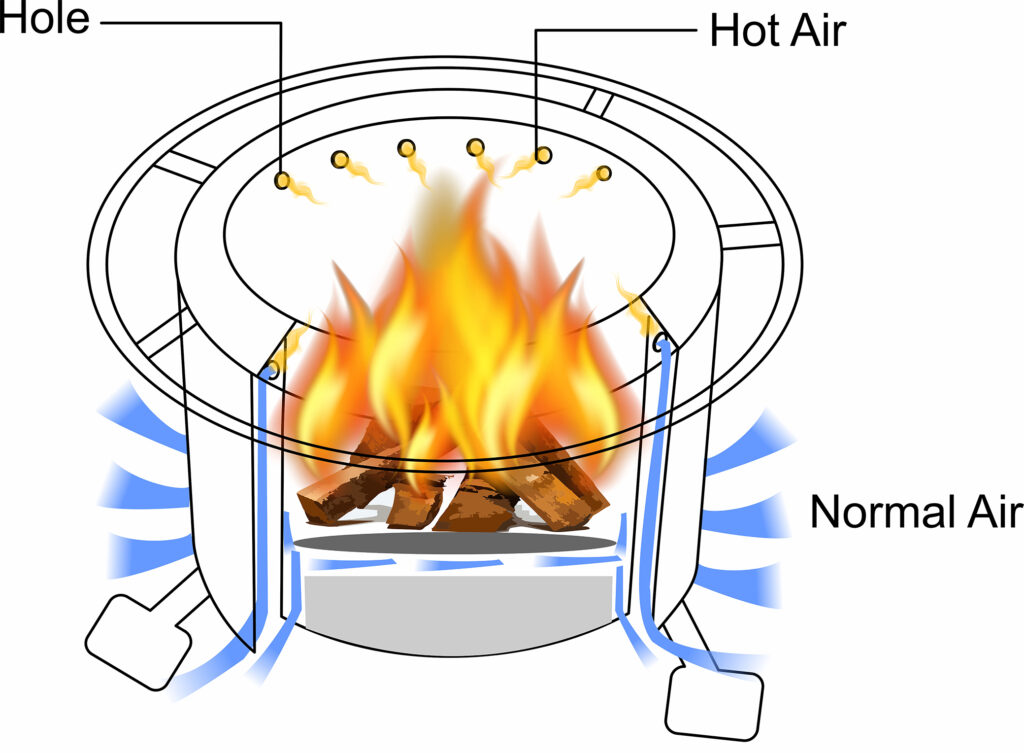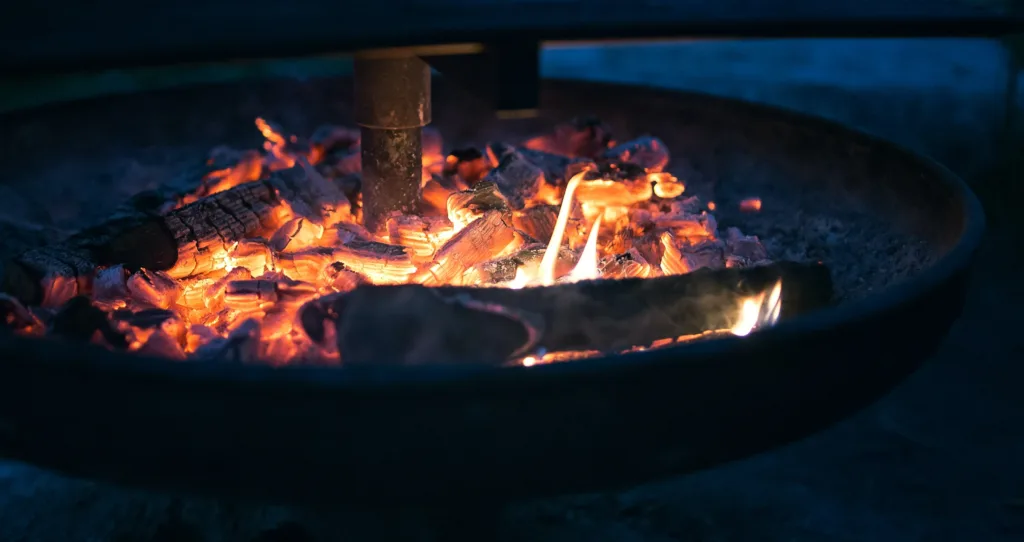Yes, we all love it (Smokeless firepits are better for the environment) because gathering around a sparkling campfire with friends, music, food, and drink is a delightful way to spend winter evenings.
Smokeless fire pits use a wide variety of fuels, including pellets, propane, firewood, and biomass. Propane pits are easy to light and make no smoke.
Are smokeless firepits better for the environment and for people than an ordinary campfire? You can use sofas, chairs, and bean bags to decorate the seating area around the fire pit.
In other cases, permanent seating is created. There are no embers that could start a fire or burn the skin.

Reason
The main reason for using a smokeless fire pit is that it reduces the smoke that is caused by the flames. They are designed in such a way that the smoke mixes with the air current and causes the smoke to burn.
Thus reducing fumes by a significant amount. Due to this, the environment remains healthy, and we remain healthy. A smoke-free environment is a thousand times better than a smoky one.
Choosing the Right Smokeless Firepit
When selecting a smokeless firepit, consider factors such as size, fuel type, and portability. Determine whether you need a firepit for a small patio or a larger backyard gathering.
Some firepits are compatible with various fuels, including wood, charcoal, and propane, providing flexibility based on your preferences. If you plan on taking your firepit on camping trips or road adventures, opt for a portable, lightweight option.
How to Use a Smokeless Fire Pit
Smokeless firepits typically employ a system that introduces preheated air into the fire chamber, allowing for more complete combustion of the fuel.
This keeps the flames hot and efficient, reducing smoke production. Some firepits use a double-wall construction and incorporate secondary combustion chambers to ensure even cleaner burning.
- Location: Choose a safe spot for your fire pit, away from flammable items and structures. Ensure proper ventilation for airflow.
- Preparation: Clear the area around the fire pit of any debris, leaves, or flammable materials.
- Fuel Choice: Opt for dry, well-seasoned hardwoods or charcoal for efficient burning and reduced smoke.
- Assembly: Follow the manufacturer’s instructions to assemble the fire pit securely.
- Ignition: Place fire starters or kindling in the pit and ignite them using matches or a lighter.
- Airflow Control: Adjust airflow vents as directed to regulate burn intensity and minimize smoke.
- Adding Wood: Gradually add larger firewood pieces once the fire is established.
- Maintenance: Keep an eye on the fire, adjusting logs to maintain a consistent burn.
- Cooking (If Applicable): Utilize a grill grate for cooking over the flames, following safety guidelines.
- Monitoring: Stay near the fire pit while it’s burning. Never leave it unattended.
- Extinguishing: Allow the firewood to burn completely. Use water or sand to extinguish the fire thoroughly.
- Cooling: Let the fire pit cool down before handling or storing it.
- Cleaning: Empty ashes and debris, following the manufacturer’s cleaning instructions.
- Storage: Store the fire pit in a dry, sheltered location, if applicable.

Benefits of using a Smokeless Fire Pit
Aside from the obvious advantage of a smoke-free experience, smokeless firepits offer several benefits. First and foremost, they are safer to use, especially in areas prone to wildfires.
The controlled combustion and reduced smoke minimize the risk of sparks and embers flying away. Additionally, with no smoke, you can gather around the firepit without worrying about smoke-induced discomfort or respiratory issues.
- Reduced Smoke: The most obvious benefit is the significant reduction in smoke production, enhancing the overall comfort and enjoyment of your outdoor fire experience.
- Improved Air Quality: With less smoke, the air around the fire pit remains cleaner and more breathable, creating a healthier atmosphere for you and your guests.
- Enhanced Ambiance: Reduced smoke means clearer visibility of the flames, allowing you to fully immerse yourself in the mesmerizing beauty of the fire.
- Less Odor: Smokeless fire pits produce fewer lingering smoky odors, preventing the unpleasant smell from permeating your clothes and surroundings.
- Healthier Environment: Enjoying a fire without excessive smoke reduces the risk of eye irritation and respiratory discomfort, contributing to a more pleasant and safer gathering.
- Cooking Possibilities: Many smokeless fire pits are designed for cooking, providing a convenient and clean platform for grilling and preparing meals over an open flame.
- Eco-Friendly: Efficient combustion in smokeless fire pits generates fewer harmful emissions, aligning with environmentally conscious practices and reducing your carbon footprint.
- Versatility: Whether in your backyard, on a patio, or during a camping trip, smokeless fire pits offer a versatile option for enjoying fires in different settings.
- Modern Aesthetics: Smokeless fire pits often come in sleek and contemporary designs, adding a stylish and sophisticated touch to your outdoor space.
- Safety: With reduced smoke, there’s less risk of accidental inhalation or visibility impairment, making the fire pit safer for everyone around it.
- Less Maintenance: Since smokeless fire pits generate less ash and residue, they often require less cleaning and maintenance compared to traditional fire pits.
- Neighbor-Friendly: Smokeless fire pits are ideal for urban environments where outdoor space might be shared with neighbors, as they minimize smoke that could disturb others.
A smokeless firepit is good for the environment
Wood burns and carbon dioxide is released into the atmosphere. Trees take in carbon dioxide and release oxygen for photosynthesis.
Without trees and other plants, humans and animals would not be able to survive. In resistance, humans breathe in, take in oxygen, and release carbon dioxide.
By lighting a smokeless fire pit, our environment will be safe. You can take an extra step towards being an eco-friendly fire enthusiast by sourcing sustainable wood.
A smokeless fire pit removes most of the smoke, and the air quality is also not affected.
Are Fire Pits Bad for the Environment
We don’t need to burn the wood that is still wet because it produces the most smoke, and the green leaves also generate a lot of smoke for a firepit.
We also have to stay away from things that are made of paint and laminated, creosote-soaked, pressure-soaked, chemicals, posters, plastics, clothes, and tires, which emit a lot of black smoke. It can also harm the environment and our health.
For a traditional firepit, we need a bundle of logs. We need a place to light the fire pit in our yard.
Whether you’re camping in the woods or just spending time in your backyard, sitting around a fire usually brings family and friends closer.
No one likes to smell smoke after a campfire, and they especially don’t like the smoke blowing out of their faces.

Maintaining Your Smokeless Firepit
To ensure long-term performance and enjoyment, proper maintenance is essential. Clean out the ashes regularly, following the manufacturer’s recommendations.
Some firepits have removable ash pans for easy disposal. Additionally, inspect and clean the air intake vents to prevent blockages that can affect combustion efficiency.
Conclusion
The smokeless firepit is good for the environment and is very good for our health too. There is no harm to those sitting near the pit.
Smokeless firepits offer a revolutionary way to enjoy outdoor fires without the annoyance of smoke. With their advanced technology and clean-burning capabilities, these firepits provide a safe and comfortable experience for gatherings, camping trips, or simple moments of relaxation.
When choosing a smokeless firepit, consider your specific needs and preferences to find the perfect fit. So why not enhance your outdoor experience and invest in a smokeless firepit today?
FAQs
What is the most environmentally friendly fire pit?
Most Environmentally Friendly Fire Pit: Opt for a propane or natural gas fire pit, which produces lower emissions compared to wood-burning fire pits. They generate less smoke and particulate matter and also don’t require cutting down trees for wood.
Are smokeless fire pits healthier?
Healthier Smokeless Fire Pits: Smokeless fire pits reduce the amount of smoke produced, making the experience more pleasant and reducing the inhalation of harmful particles. However, they still produce some emissions and should be used in well-ventilated areas.
What is the science behind smokeless fire pits?
Science Behind Smokeless Fire Pits: Smokeless fire pits work by introducing more air into the combustion process, which allows the wood to burn more efficiently. This reduces smoke as a result of better combustion and more complete burning.
What are the disadvantages of a fire pit?
Disadvantages of Fire Pits: Wood-burning fire pits contribute to air pollution due to the emissions of smoke, carbon monoxide, and fine particulate matter. They also require a continuous supply of wood and necessitate regular cleaning of ash and soot.
1. Are smokeless firepits completely smoke-free?
While smokeless firepits significantly reduce smoke, they may still emit a small amount of smoke during initial ignition or when using certain fuels. However, the amount of smoke produced is minimal compared to traditional firepits.
2. Can I use a smokeless firepit indoors?
Smokeless firepits are primarily designed for outdoor use. It’s important to follow the manufacturer’s guidelines and safety instructions when using any firepit indoors or in enclosed spaces.
3. Do smokeless firepits require special fuel?
Smokeless firepits can typically accommodate various fuel types, including wood, propane, or natural gas. However, it’s recommended to check the specifications provided by the manufacturer to ensure compatibility with your preferred fuel source.
4. Are smokeless firepits more expensive than traditional firepits?
Smokeless firepits generally come at a higher price point due to their advanced combustion technology and design. However, the long-term benefits in terms of fuel efficiency and reduced environmental impact may outweigh the initial investment.
5. Can smokeless firepits be used for cooking?
Some smokeless fire pits are designed with cooking capabilities, allowing you to enjoy outdoor grilling or cooking experiences. Always refer to the manufacturer’s instructions regarding cooking on your specific firepit model.
Review
Rose J: “I’ve been using a smokeless fire pit for a while now, and it’s been a game-changer. The reduction in smoke is remarkable, and it creates a much more enjoyable atmosphere for everyone gathered around. Plus, knowing that it’s better for the environment gives me peace of mind. I highly recommend it!”
Harvey P: “Smokeless fire pits are an excellent addition to any outdoor space. The fact that they produce minimal smoke means I can enjoy a cozy fire without the irritating smoke that usually follows. It’s a win-win for me and the environment!”
Daniel: “I’ve recently switched to a smokeless fire pit, and I’m impressed. It’s incredible how little smoke it produces, making it a pleasant experience for my family and friends. It’s definitely a step towards being more environmentally conscious.”
Benjamin: “I have mixed feelings about smokeless fire pits. While the reduced smoke is a definite advantage, I can’t help but wonder about the environmental impact of the fuel source, especially if it relies on fossil fuels. I’m still weighing the pros and cons.”
Elijah J: “Smokeless fire pits are a great alternative to traditional fire pits. The minimal smoke and emissions are perfect for those with respiratory issues or sensitivity to smoke. It’s a thoughtful choice for both comfort and environmental reasons.”

Pingback: How does smokeless firepit work - lawnsroot.com